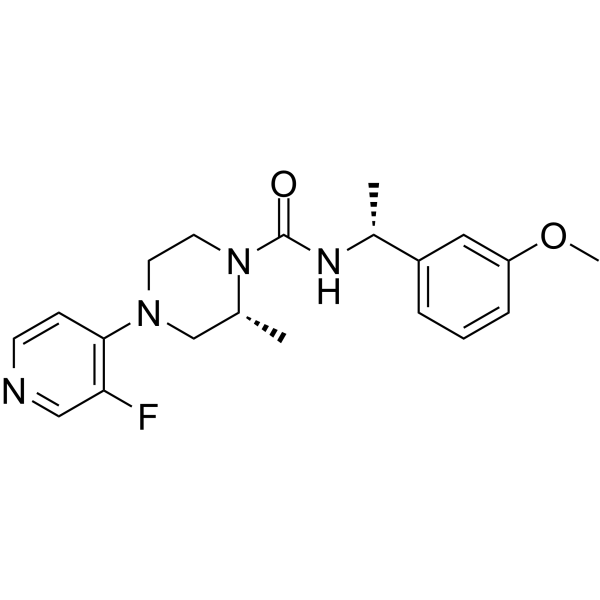| In Vivo |
Rho-Kinase-IN-2 (Oral adiministration; 10 mg/kg; 6 times; 0.5, 1, 2, 4, 8, and 12 h) treatment shows dose- and time-dependent ROCK1 and ROCK2 target engagement[1]. Rho-Kinase-IN-2 (Oral adiministration; 10 or 20 mg/kg; QD or BID; 2 weeks) treatment shows excellent tolerability assessment[1]. Rho-Kinase-IN-2 (Oral adiministration; 1-20 mg/kg; once) treatment shows a direct dose- and time-dependent relationship between brain exposure and MYPT1 phosphorylation status[1]. Rho-Kinase-IN-2 (Oral adiministration; 10 or 20 mg/kg; once) treatment decreases in the mean arterial, systolic, diastolic blood pressure, and heart rate[1]. Rho-Kinase-IN-2 (Oral adiministration; 10 mg/kg; twice a day; 90 days) treatment leads to lower-than-expected brain concentrations[1]. Animal Model: Male C57BL/6 mice[1] Dosage: 10 mg/kg Administration: Oral adiministration; 10 mg/kg; 6 times; 0.5, 1, 2, 4, 8, and 12 h Result: Observed dose- and time-dependent ROCK1 and ROCK2 TE, with a free brain KiNativ ROCK1 and ROCK2 IC50=∼6 nM. Animal Model: 3−4 months old heterozygote Q175DN KI and wild-type littermate mice[1] Dosage: 10 or 20 mg/kg Administration: Oral adiministration; 10 or 20 mg/kg; once a day or twice a day; 2 weeks Result: Scored neurological index normally at all doses although a slight loss in bodyweight (∼2%) in the 20 mg/kg treatment group. Animal Model: Heterozygote HTT zQ175DN knock-in mice[1] Dosage: 1-20 mg/kg Administration: Oral adiministration; 1-20 mg/kg; once Result: Remained over MYPT1 IC50 for over 2 h of the free brain at 10 mg/kg, and observed the dose- and time-dependent inhibition of MYPT1 phosphorylation in the striatum following acute in vivo dosing. Animal Model: CD1 mice[1] Dosage: 10 and 20 mg/kg Administration: Oral adiministration; 10 or 20 mg/kg; once Result: Observed the decreases in the mean arterial (maximum change of 61.0 ± 8.5 mmHg from baseline), systolic (maximum change of 59.5 ± 8.4 mmHg from baseline), diastolic blood pressure (maximum change of 56.4 ± 9.0 mmHg from baseline), and heart rate (maximum change from predose of 107 bpm) when compared to the control group from ∼0.5 to 2 h post dose. Animal Model: Heterozygote Q175DN KI mouse model of HD[1] Dosage: 10 mg/kg Administration: Oral adiministration; 10 mg/kg; twice a day; 90 days Result: Led to lower-than-expected brain concentrations compared to single dosing.
|
